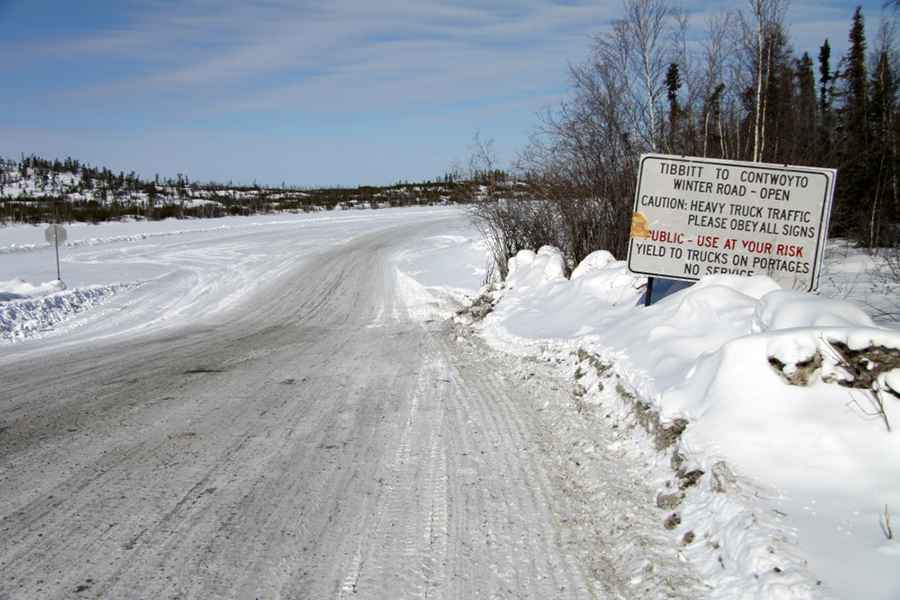Tibbitt to Contwoyto Winter Road is the world’s longest heavy haul ice road
Tibbitt to Contwoyto Winter Road is an ice road located in the Northwest Territories and Nunavut in Northern Canada. The road, named after the first and the last lakes on the ice road, was built for the first time in 1982. It is a supply route for several gold and diamond mines in the Canadian arctic.

Where is Tibbitt Contwoyto winter road?
Formerly known as Echo Bay Mines Ltd.'s Lupin Winter Road, the road is located in the Northwest Territories and Nunavut in Northern Canada, serving mines and exploration activities.
How long is Tibbitt to Contwoyto Winter Road?
Each year, the North's mining industry constructs what is arguably the world’s longest heavy-haul ice road, stretching 600 kilometers (372 miles) into Canada’s northern tundra. Eighty-five percent of the road is built over frozen lakes, and 15% on over 64 land portages between lakes. It’s said to be the world's longest heavy-haul ice road. It is a region served by no other highways and for 10 months of the year accessible only by air. This annual ice road (TCWR) was first built in 1982 to service mines and exploration, following part of the original road that was cleared to the Tundra Mine in 1960–1961. The ice road is built by a joint venture of mining companies (Diavik Diamond Mines Inc., Dominion Diamond Corporation, and De Beers Canada Inc.) operating in the area and shared by many users, from exploration companies to tourism outfitters and Aboriginal hunters of the region. The road is capable of withstanding high levels of traffic; during the two years of mine construction, Diavik transported over 7,000 truckloads of fuel, construction material, cement, bentonite, explosives, and reinforcing steel to its mine site. In 2012, Diavik shipped 3,160 loads (89,000 tonnes) over the winter road. This included 60 loads of materials needed to construct a wind farm.
Is Tibbitt to Contwoyto Winter Road open?
Always check the weather forecast before you start your journey: adverse conditions are common. This seasonal winter road (also called Denison's Road) is only open for eight to nine weeks each year, from February to the beginning of April (depending on weather and the season's load requirements) and must be constructed each year to service mines in the area. Expect high winds, storms, and poor visibility often. All drivers are urged to carry proper winter clothing and survival equipment, as weather conditions can change quickly.
Where does Tibbitt to Contwoyto Winter Road start and end?
The road begins about 65 km (40 mi) east of Yellowknife at the end of Highway 4. It begins at the end of the Ingraham Trail, about 65 km northeast of Yellowknife, and runs about 400 km to Ekati Diamond Mine near Lac de Gras. Historically, the winter road was about 600 km long and went all the way to the now-defunct Jericho Mine on the north shore of Contwoyto Lake in Nunavut. It takes around 6 weeks to be completed and operates for eight to ten weeks starting in the last week of January. Tibbitt to Contwoyto Winter Road has 2 different lengths: 400 and 600 km (250 and 370 mi) long, but ends in Jericho Diamond Mine, at the north end of Contwoyto Lake, in Nunavut.
How long does it take to drive the Tibbitt to Contwoyto Winter Road?
To travel the road, the expected time is around 14 hours, but for heavily loaded trucks, the time can be as high as 18 hours. The entire Tibbitt-to-Contwoyto road system is only meant for transport traffic to and from the mines. However, the roads are inevitably also used by recreational drivers. Anyone going out on the roads past the Ingraham Trail this winter should be well prepared and equipped with a VHF radio to communicate with truckers along the way. This ice road was the location of the first season of the television series Ice Road Truckers, on The History Channel, in 2007.
Is the Tibbitt to Contwoyto Winter Road safe?
Keep a safe distance from the trucks and remember that trucks take a little more time to move, and they're not quite as quick as motor vehicles so a little patience would be appreciated. Most of the difficulty comes in when people want to go too fast on the road, and you have to remember that you're on an ice road so if you make a quick move, do a sudden brake, or accelerate too hard, it's very easy to lose control if you're not careful. Speed on the road is carefully controlled to protect the ice. The speed limit for fully loaded trucks on the ice is 25 km/h (16 mph). But in some points, due to the ice thickness, the speed is reduced to only 10 km/h (6.2 mph). This is one of the safest highways in Canada. For example, in 2007 almost 11,000 truckloads were hauled and there were only nine minor incidents that resulted in only one minor injury. While reality TV may have portrayed the road as dangerous or reckless, it’s actually the complete opposite: it’s built, maintained, patrolled, and constantly monitored for thickness and safety by a highly professional team.
Pics&more info: http://www.rcinet.ca/eye-on-the-arctic/2012/08/27/canadas-ice-road-to-diamonds/